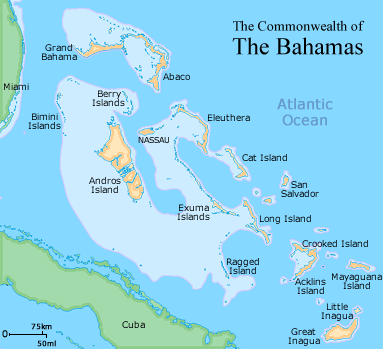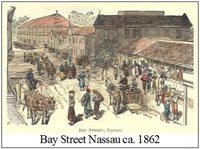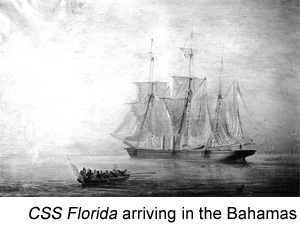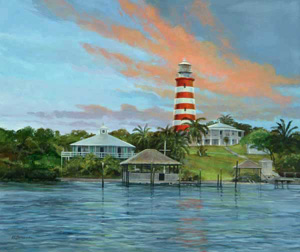
Volume
27, No. 1 – January 2014
Volume 27, No. 1
Editor: Stephen L. Seftenberg
Website:
www.CivilWarRoundTablePalmBeach.org
President's Message
January 8, 2014 Program
The Roundtable’s version of Lunt and Fontanne are at it again. This
time, Ms LaRovere will be the intrepid newspaper reporter interviewing
Daniel Edgar Sickles (William McEachern), a lawyer, politician,
alleged murderer, inventor of the temporary insanity defense, political
general, "war hero for losing his leg in a battle that he almost lost
due to his incompetence, scandalous womanizer and much more! Any one who
witnessed the interview of David Davis last year will not want to miss
this!
December 11, 2013 Program
Robert Macomber, "The Bahamas and the Civil War"
As a preface to his entertaining discussion of the
role of the Bahamas in the Civil War, Macomber first led us through a
short outline of "Admiralty Prize Law." He grew up as a sailor and
always wanted to be an Admiralty lawyer because Admiralty lawyers got to
go to interesting places, interview a few people and then swizzle rum
drinks while relaxing under a palm tree. Unfortunately, 40 years ago
while Macomber was a College junior, he met a real Admiralty lawyer. The
man looked tired. He explained that there were only three admiralty law
firms in Florida, one in Miami, one in Tampa and one in Jacksonville. He
told our speaker, "For the first 20 years you will do all the paperwork,
you will do research for 10 to 14 hours a day, all for a pittance. After
20 years, you may get to be a Junior Partner and make a little more
money. You will be entitled to do all the cool stuff you imagined when
you are a senior partner, but by then you will be too old to enjoy it!
The Federal District Courts also sit as Admiralty
Courts. The judge wears two hats. Captured blockade runners were tried
as smugglers under Criminal Law (they were deemed innocent until proven
guilty). However, a prize proceeding during time of war was an in rem
proceeding in which the defendant was the ship and its cargo. A U. S.
naval officer would literally read a "libel" against the captured ship,
which was presumed to be either an "enemy combatant" or an "enemy
merchant ship carrying enemy cargo." The presumptions were reversed: the
ship and its cargo were presumed guilty and the burden was on it to
prove it was innocent! In another reversal of form, "hearsay" (written
third party testimony), usually prohibited in a criminal trial, was
accepted in a prize trial, which made cross examination impossible. Why
was hearsay permitted? The only witnesses were officers and sailors who
had gone back to sea. "Real" evidence consisted of the cargo manifest
and the log books. Finally, no juries and the judge alone decides the
case. If, as usually was the case, the judge orders that the ship and
its cargo be condemned and auctioned off by the U. S. Marshall. The
proceeds were divided between (1) the U. S. Marshall (to recover his
out-of-pocket costs, including dockage fees, costs of unloading the
cargo), (2) legal expenses (lawyers’ fees, court costs) and (3) U. S.
Naval officers and crews (the Admiral in command of the blockade
squadron gets 1/12th, the commander of the victorious ship
another1/12th, the officers split 1/12th and the crew splits 1/6th.
Prize money is a great incentive for a sailor to enlist in blockade
duty, since ordinary seaman’s wage is only $13 a month ($14 after he is
promoted). Union officers and soldiers get no prize money and they have
to march around in mud and snow, eat lousy food, catch terrible diseases
and get shot at.
The East Gulf Blockade Squadron captured over 350 blockade runners
and took them to the Admiralty Court in Key West for trial and sale.
Many other blockade runners were sunk or scuttled. Many U. S. officers
were disgusted with having to chase and capture the same blockade runner
over and over. Finally, in 1863. someone in Washington got smart and
stopped selling these ships back to the fronts for the blockade runners.
From then on, the U. S. Navy condemned the ships and converted them for
use against the blockade runners. A prime example was the schooner
America, that won the first international race (now called the
America’s Cup), in 1851. In the beginning of the war, it was
converted to a blockade runner but was trapped up the St. John’s River
and scuttled by its crew. The Union Navy raised her and refitted her as
the USS America and put her to work catching blockade runners!
 Two
important issues had to be decided with respect to the Union "Anaconda
Plan": Two
important issues had to be decided with respect to the Union "Anaconda
Plan":
(1) The Treaty of Paris (1856) had outlawed privateering. The United
States was the only seafaring nation not to sign it because of its
history of authorizing privateers in the American Revolution and the War
of 1812. After First Manassas (Bull Run to Yankees), the European
nations had to decide if the Confederacy was a legitimate "belligerent."
If it were not, ships flying the Confederate flag would be deemed to be
pirates. If it were a belligerent, would the Europeans side with it or
declare themselves to be neutral. England, France and Spain all found
the Confederacy to be a "belligerent" but decided to be neutral, at
least for the nonce.
(2) Was the Union blockade "effective"? If it were, then the European
navies would have to honor it and prevent blockade runners from using
the Bahamas, Cuba and Bermuda. At first the blockade was a joke. The U.
S. Navy had only 12 ships to man a blockade stretching from Chesapeake
Bay to the Rio Grande! To be effective, a blockade must blockade ships
attempting to enter every port. One Northern tactic was to reduce
the number of ports open by capturing them (e. g. Norfolk, New Orleans,
Mobile, etc.) By the end of the war, only Wilmington, North Carolina,
remained in Confederate hands. Another tactic was the "stone" fleet:
derelict vessels were filled with stone and sunk in Charleston and other
harbors. This tactic outraged the Europeans as "vindictive, "vandalism"
and "illegal," but Secretary of the Union Navy Gideon Welles stuck by
his guns. There were only 1,457 officers and 7,600 seamen in the federal
navy; by war’s end this number would increase to 672 ships, 7,500
officers and 51,500 seamen. These men would man an extraordinary fleet
of ships built up by the Union, including the new ironclads, which would
change the face of maritime warfare. By repairing available ships,
building new ones, and adapting commercial vessels the Union Navy had
212 seaworthy vessels in January 1862. As the Union’s feverish efforts
progressed, by 1864 the blockade began to choke the life out of the
Confederacy.
The Union naval blockade ships often illegally intruded within three
miles of Cuban or Bahamian shore, but whenever complaints from the
foreign nations finally reached Welles, he primly responded, "Our navy
would never do that." Of course, when three ships from the East Gulf
Squadron actually ran aground on Cuban reefs, he finally had to admit
the violation of international law. The last wreck was of USS San
Jacinto, which had become famous in the Trent affair. It
turned out that at 12:14 A. M., January 1, 1865, an ensign was left
alone on deck while all the other officers were enjoying themselves
below. The hapless ensign ran the vessel onto the reef. The San
Jacinto is still visible! Then the salvors sprang into action. First
they did save Captain Richard N. Meade and his crew, who were then
reduced to living under tents on the beach. The salvors extracted $300
in gold from Meade before they flagged down a Bahamian ship to take two
officers to Key West. Not all of Meade’s crew were willing to wait for
"rescue" which would mean returning to the tough life aboard a blockade
ship. At least one-third of his crew deserted to a nearby Confederate
blockade runner. The Confederate skipper suspected a Yankee trick and
put them in irons for five days before releasing them.
 Of
course, the European nations also violated national and international
laws: Spain and France took the opportunity to reclaim the Dominican
Republic and Mexico, counting on the distraction of the Civil War to
blunt any action by the North to enforce the Monroe Doctrine. Of
course, the European nations also violated national and international
laws: Spain and France took the opportunity to reclaim the Dominican
Republic and Mexico, counting on the distraction of the Civil War to
blunt any action by the North to enforce the Monroe Doctrine.
Who benefitted the most from the Civil War? Not the South, which was
prostrated. To an extent the North expanded its economy and was on its
way to becoming a world power. But one little English colony, the
Bahamas , owes its economic boom to the blockade! A glance at
the map shows the herculean task facing the East Gulf Squadron if it
wanted to stop blockade runners from entering or leaving the many
islands. When the war started, the Bahamas’ economy was flat on its
back, but by 1862 it had become the number one blockade running port and
its population had exp anded
six-fold! All the big buildings you now see along Bay Street were built
in 1862! The Royal Victoria Hotel was filled 24/7 with blockade runners,
British naval officers and cotton brokers. Fortunes were made in the
hotel bar! The colonial government was pro-Southern and soon brought any
British naval officers who attempted to enforce neutrality to heel. anded
six-fold! All the big buildings you now see along Bay Street were built
in 1862! The Royal Victoria Hotel was filled 24/7 with blockade runners,
British naval officers and cotton brokers. Fortunes were made in the
hotel bar! The colonial government was pro-Southern and soon brought any
British naval officers who attempted to enforce neutrality to heel.
A prime example: CSS Florida, built in Liverpool under a false
name, Oreto, reached Nassau in April 1862, but not without some
misadventures. First HMS Bulldog seized the ship but after being
talked to by the governor released her! Then HMS
 Greyhound
seized her and towed her into Nassau harbor. The Admiralty Court
proceeding took all of thirty minutes – court was convened at 11:30 AM
and the ship was returned to its commander at noon! Later HMS Petrel
actually towed the ship (still calling itself Oreto) during a
storm! While Oreto was allowed to fill her bunkers with coal
(despite being entitled to only enough coal to make it to the nearest
Confederate port), the governor of Nassau drew the line at permitting
Oreto to take on arms and stores in the middle of Nassau harbor.
Instead he looked the other way when she sailed to isolated Green Cay
and there took on stores and arms and was commissioned CSS Florida
on August 17, 1862 with CSN. John Newland Maffitt in command. In an
earlier talk Macomber had described Maffitt’s epic raids on New England
in 1863. Ironically, many if not most of the seamen manning the
Confederate raiders were Englishmen. Greyhound
seized her and towed her into Nassau harbor. The Admiralty Court
proceeding took all of thirty minutes – court was convened at 11:30 AM
and the ship was returned to its commander at noon! Later HMS Petrel
actually towed the ship (still calling itself Oreto) during a
storm! While Oreto was allowed to fill her bunkers with coal
(despite being entitled to only enough coal to make it to the nearest
Confederate port), the governor of Nassau drew the line at permitting
Oreto to take on arms and stores in the middle of Nassau harbor.
Instead he looked the other way when she sailed to isolated Green Cay
and there took on stores and arms and was commissioned CSS Florida
on August 17, 1862 with CSN. John Newland Maffitt in command. In an
earlier talk Macomber had described Maffitt’s epic raids on New England
in 1863. Ironically, many if not most of the seamen manning the
Confederate raiders were Englishmen.
 In
1864, the Bahamian government built a "candy cane" lighthouse especially
for the blockade runners, over the objections of the salvors, who
profited from salvaging wrecks! In addition, the blockade runners got
the best charts and the best pilots. Business was so profitable that
many blockade runners and cotton brokers were able to bribe Union
blockade skippers. A small sailing vessel would pay $1,000 up front and
$5,000 when the vessel returned to Nassau, while a larger schooner paid
$5,000 up front and $15,000 in gold upon return. In
1864, the Bahamian government built a "candy cane" lighthouse especially
for the blockade runners, over the objections of the salvors, who
profited from salvaging wrecks! In addition, the blockade runners got
the best charts and the best pilots. Business was so profitable that
many blockade runners and cotton brokers were able to bribe Union
blockade skippers. A small sailing vessel would pay $1,000 up front and
$5,000 when the vessel returned to Nassau, while a larger schooner paid
$5,000 up front and $15,000 in gold upon return.
For the Bahamas, the Civil War did not end with Lee’s surrender at
Appomattox, because Judah Benjamin, who had served the Confederacy in
three cabinet positions: Attorney G eneral,
Secretary of War and Secretary of State, escaped to England via the
Bahamas. In June 1866, Benjamin began a successful and eventually
lucrative career as a barrister. In 1868, he published his Treatise
on the Law of Sale of Personal Property, which was regarded as one
of the classics of its field and as Benjamin's Sale of Goods
remains authoritative. He was influential in commercial law that
supported the rise of Great Britain as an imperial power. In 1872, he
was selected as Queen's Counsel. Benjamin retired in 1883 on his
doctor's advice. He had earned $720,000 during his nearly two decades at
the bar in London. He moved to Paris, where his daughter Ninette and
three grandchildren lived. He died there on May 6, 1884. eneral,
Secretary of War and Secretary of State, escaped to England via the
Bahamas. In June 1866, Benjamin began a successful and eventually
lucrative career as a barrister. In 1868, he published his Treatise
on the Law of Sale of Personal Property, which was regarded as one
of the classics of its field and as Benjamin's Sale of Goods
remains authoritative. He was influential in commercial law that
supported the rise of Great Britain as an imperial power. In 1872, he
was selected as Queen's Counsel. Benjamin retired in 1883 on his
doctor's advice. He had earned $720,000 during his nearly two decades at
the bar in London. He moved to Paris, where his daughter Ninette and
three grandchildren lived. He died there on May 6, 1884.
After responding to several questions, Mr. Macomber received a
well-deserved round of applause.
Last changed: 12/16/13
Home
About News
Newsletters
Calendar
Memories
Links Join
|

